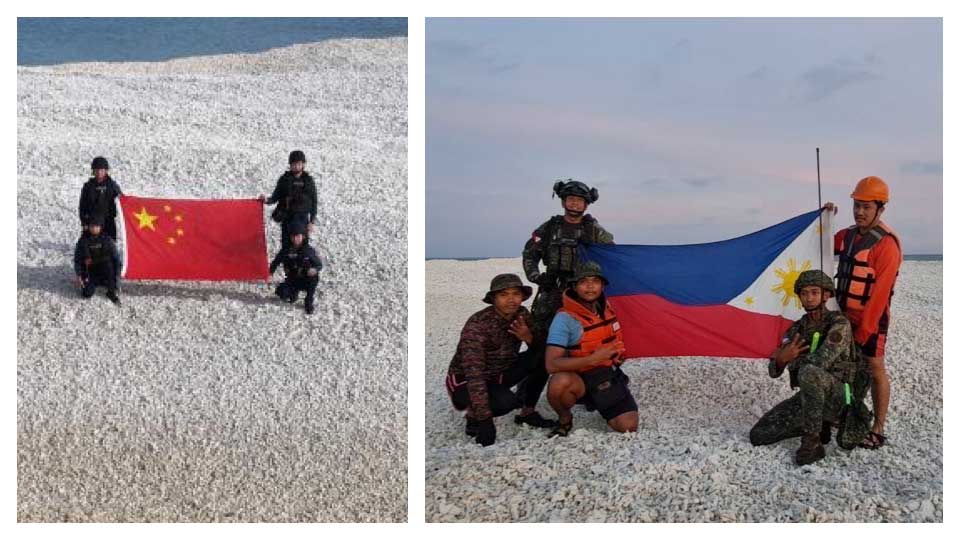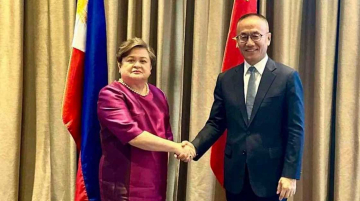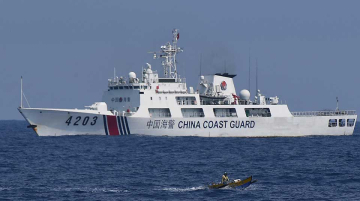
A flag war unfolded on a disputed sandbank in the South China Sea between China and the Philippines. No shots were fired, but the symbolism was deafening.
Last week, four Chinese coast guard officials conducted maritime control and planted flags in Sandy Cay, a sandbank in the contested Spratly Islands.
Days later, Philippine personnel responded by planting their flag on the same reef.
Though no military confrontation broke out, tensions simmered. Liu Dejun, spokesperson for the China Coast Guard, urged the Philippines “not to infringe on their jurisdiction” over Sandy Cay, which is known as Tiexian Jiao in China and Pagasa Cay 2 in the Philippines.
The Philippines defended the move as a lawful and routine maritime exercise.
Vietnam, too, raised objections to both countries for their actions on the sandbank.
Sandy Cay: A Spark in Waiting
This disagreement over a small sandbank is just a small part of a larger issue. Despite being tiny in land mass, Sandy Cay risks becoming the latest flashpoint in the long-running South China Sea territorial dispute.
The fact that neither China nor the Philippines escalated after planting their flags shows just how fragile the status quo is.
It’s a reminder that in these contested waters, a minor incident can potentially escalate into a full-blown crisis.
The recent standoffs between India and Pakistan in Kashmir, and between India and China along their contested border, are stark reminders of how quickly fragile diplomacy can give way to confrontation—and how easily the next flashpoint can ignite.
The Case for Defense Diplomacy
Despite rising tensions, this episode could end well—if claimants continue to exercise restraint and strengthen maritime defense diplomacy.
While the immediate challenge may seem manageable, the long-term solution is to reinforce communication channels and trust-building.
At the heart of the solution lies maritime defense diplomacy, which involves creating multiple layers of meetings and negotiations to build trust, improve communication, and manage conflicts—measures that can help prevent provocative actions among claimants and reduce the risk of incidents escalating into crises.
There’s a growing recognition of the importance of defense diplomacy. China and the Philippines have conducted several bilateral meetings to manage the conflict, including earlier this year to de-escalate tensions around Second Thomas Shoal Shoal.
These dialogues have proven valuable in maintaining a fragile peace in the South China Sea, but more expansive frameworks are required.
Bilateral and Multilateral Dialogues: Limited but Necessary
While bilateral diplomacy is a start, it is far from enough. The solution requires expanding dialogue to include all claimants, which is why trilateral discussions are crucial.
A meeting between China, the Philippines, and Vietnam would be essential in addressing the complexities of overlapping claims in the South China Sea.
Vietnam, which has historically balanced its diplomatic approach toward China, may be reluctant to engage in direct dialogue with Beijing on these terms. However, including Vietnam in these conversations is critical for regional stability and peace.
Maritime defense diplomacy has already proven successful in other contexts. In August last year, the Philippines and Vietnam signed a landmark Defense and Maritime Cooperation Agreement.
This agreement, along with a joint Coast Guard exercise in Manila Bay in 2023, exemplifies how cooperation between claimants, however modest, can still create vital trust and demonstrate a shared interest in maintaining peace.
What ASEAN Has—and Hasn’t—Done
Diplomacy must go beyond the direct claimants. The South China Sea is a strategic corridor—any flare-up will ripple across the Indo-Pacific.
ASEAN must step up its defense diplomacy efforts. While ASEAN and China have agreed on a Code of Conduct (CoC), progress has been slow and uneven.
The CoC remains a work in progress, and without tangible action, it risks becoming a diplomatic deadlock.
ASEAN has also established the ASEAN Coast Guard Forum, which has been held twice in Indonesia and, most recently, in the Philippines last June.
These forums have produced positive results, such as the SEA-PEACE protocol—an agreement on the Protocol of Engagement at Sea for Coast Guard and Maritime Law Enforcement.
Additionally, the forums have created working groups focused on capacity building, information sharing, and operational cooperation. These initiatives, while vital, are still hindered by a lack of political will and coordination among ASEAN member states.
Expanding Defense Diplomacy Beyond ASEAN
The Philippines has also increased its maritime partnerships beyond ASEAN, reducing its reliance on unilateral deterrence or U.S. backing.
In addition to its ongoing defense cooperation with the United States, the Philippines has signed new defense agreements with countries such as France and New Zealand.
Meanwhile, a recent defense cooperation agreement between the Philippines and New Zealand was signed on April 30, 2025. These partnerships are crucial in reinforcing defense diplomacy in the South China Sea rather than escalating military tensions.
China’s Moment to Lead Differently
So what should China do? Now is the right time for China to win the hearts of Southeast Asians through restraint, diplomacy, and cooperation.
This is especially timely as the United States faces declining regional favor under the Trump 2.0 administration. The strategic vacuum is an opportunity for China to engage, not dominate.
But trust is fragile.
A recent survey from the ISEAS–Yusof Ishak Institute in Singapore found that 48.2% of ASEAN-10 respondents view China’s encroachments into Exclusive Economic Zones and continental shelves as the most worrying development in the region.
Respondents also feared an accidental confrontation between China and an ASEAN state that could spiral into crisis.
Militarization and assertiveness by China in the South China Sea remain top concerns.
Diplomacy Over Conflict
Being a significant power doesn’t mean standing alone. Power does not have to be coercive. It can, and should, take the form of inclusive defense diplomacy.
The South China Sea remains one of the most contested maritime zones. But bilateral, trilateral, and multilateral diplomacy is still the most inclusive and viable option for all parties involved.
The waters are already crowded. What’s needed now is not more muscle, but more trust, dialogue, and diplomacy, before the next flag turns into a firestorm.
Anak Agung Banyu Perwita is a professor of international relations at the Republic of Indonesia Defense University, co-authored this article.





